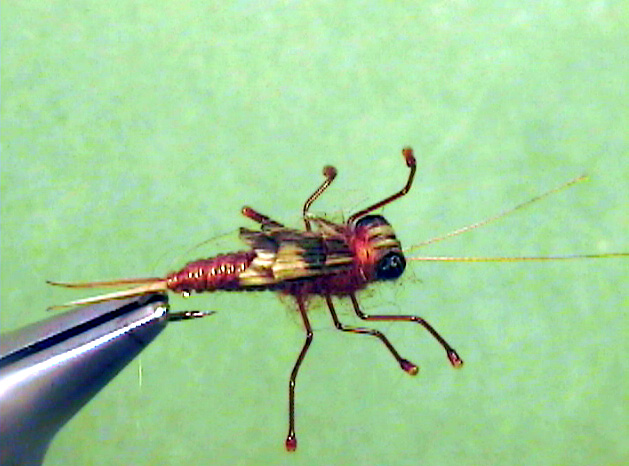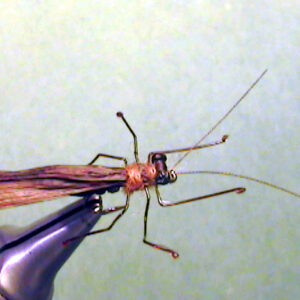Hook Size: 14
The Perfect Fly Little Brown Stonefly nymphs crawl out of the water to hatch in the mid to early afternoons and on into the evening. The hatch into adults on the banks or rocks out of the water. You should fish the fly near the banks while they are hatching.
Fishing imitations of the nymphs during and just prior to a hatch is the most
productive method to use for both the Taeniopterygidae and Nemouridae
families of Early Brown Stoneflies. As most of you know, at the time these
stoneflies are hatching there are a lot of other mayfly and caddisfly hatches
going on. During that time, most anglers will tend to fish the dry fly and I certainly
don’t blame them for that. Most of them will probably use a mayfly imitation. The
only point I want to make regarding this, is that there are times and places
during the late spring and summer months that fishing an imitation of a stonefly
nymph may be your best bet. Certainly when you observe stoneflies hatching
and there are no other major mayflies or caddisflies hatches occurring, you may
find the stonefly nymph fly to be effective.
Prior to hatching, these nymphs stay hidden down between and under the rocks
and cobble on the bottom of the stream. They are not very available for the trout
to eat. By far the best time to imitate these nymphs is just prior to the time a
hatch begins. Since there are several different species of these stoneflies, this
may be anytime from late winter to the middle of summer. Because there are so
many species, there is no way to determine an exact dates, so the best way to
determine if a hatch is occurring is to observe the stream side vegetation and
rocks. If you see any adult stoneflies that are less than five-eights of an inch
long, they are probably Little Brown Stoneflies. If no other major hatches of
mayflies or caddisflies are occurring, you should fish an imitation of the Little
Brown Stonefly nymph.
Presentation:
You should present the nymph by casting up and across the stream and
bringing the fly back to the bank along the bottom. In many cases you should
position yourself well away from the edge of the water because trout will
sometimes intercept these nymphs in very shallow water right next to the banks.
It is not necessary to only allow the fly to dead drift. You can slowly hand retrieve
the fly on the bottom cross current if necessary to get it back to the bank.
It is best to do this early in the mornings or late in the afternoons. If you don’t get
any results, most likely the hatch has already ended. These stoneflies can live
for several days. If you are lucky, you may find the hatch is underway and you
may just experience some fast action as a result of it.
If you carefully observe the banks of the stream early and late in the day, you
may find the stoneflies actually hatching. If the weather is cold, you may find the
adults crawling on the banks, in a fairly inactive state. On very cold days after a
hatch starts, you may find them in the road on the black top pavement.
In summary, if you start seeing small, little black looking, dark brownish red or
brown adult stoneflies in the late winter or early spring and no major mayfly or
caddisfly hatch is underway, try fishing a imitation of a stonefly nymph along the
banks early in the day or late in the afternoon.
Copyright 2013 James Marsh

